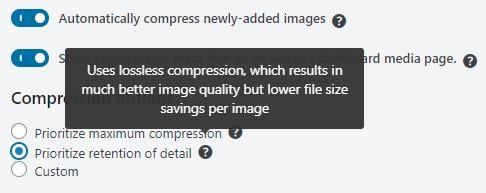With WP-Optimize’s smushing image compression feature, many people may be unaware of the advantages and disadvantages of the Lossy and Lossless compression methods. This blog will explain in detail what kind of results and savings you can expect to achieve with each compression format.
Lossy Compression
The most popular image compression for most users is Lossy, which can be categorized as achieving greater space saving compression (compared to Lossless), but losses some of the data and image quality from the original image in the compression process. While you can save more data with Lossy, the data saving isn’t completely without cost, as with increased compression comes a slight increased degradation in the image quality and the inability to you reverse the compression, which results in the permanent loss of file metadata.
You should choose the Lossy method of compression If you are purely trying to reduce the size of your images and save data. But remember that the advantage of smaller files will be tempered by the small reduction in quality in your images and the permanent loss of metadata.
This isn’t to say that your new compressed image will resemble a digital camera photo from 2002 however. The image will still be very high quality and present as a professional and clear image, but you may start to get some compression artifacts appear with high levels of compression.
With Lossy compression enabled, the below image was compressed from 230.26 KB to 64.92 KB, giving an almost 75% reduction in size.
Lossy Summary
Pro – Can reduce the images to small sizes and save lots of file data, making your website load quicker and perform better.
Con – The smaller you make the file size, the lower the quality of your original image. Deletes original image data permanently.
Lossless Compression
Lossless is a term that refers to a class of data compression algorithms that compresses your image, but allows the original data to be restored and reconstructed from the compressed file data should you ever need it. Lossless compression differs to Lossy by maintaining the original image quality, while reducing the image data size by removing unnecessary meta-data from the submitted files (usually JPEG or PNG files). The main benefit of this type of compression is that the user has the ability to keep all the original data and revert to the original image, but can still achieve a smaller file size, without sacrificing image quality.
As previously mentioned, one of the main benefits of Lossless compression is being able to keep and restore every single bit of data that was within the file after it is uncompressed. This is in contrast to Lossy compression, where metadata is not saved during the compression process and results in data being unable to be restored should you wish to reverse the compression.
As a Lossless image will only temporarily delete the file data, this allows it to be transferred quicker, which results in faster loading speeds for your website. While the amount of space you will save is not as much as if you were to use Lossy compression, it does give you higher quality images and the option to fully restore should you need it.
With Lossless compression enabled, the below image was compressed from 230.26 KB to 172.18 KB, giving just over 25% reduction in size.

Original JPEG image

Converted with Lossless compression. Every pixel is identical to the original image – only the file size is smaller

Original image zoomed in 300%
Lossless Summary
Pro – Decreases image file size but maintains original quality of image. Full restoration of data available.
Con – Using Lossless compression results in larger files sizes in comparison to Lossy compression, which can result in slower loading speeds.
Custom
We understand that some users may wish to decide their own balance between maximum compression and best image quality. With the custom option, you can manually choose which settings your prefer for image compression and save them for future use.
Lossy vs Lossless image compression summary
If you have a website that needs to showcase high quality photographs (such as a wedding photography business), you should stick to Lossless compression as it will still display your images in their original highest quality. But if your site is for a local garage for example, where the highest quality images are not so important, Lossy compression could work best as original high quality photos are not essential to the success of your business. Install WP-Optimize today and choose between Lossless or Lossy compression, depending on what you want to achieve and what works best for your site and users.





